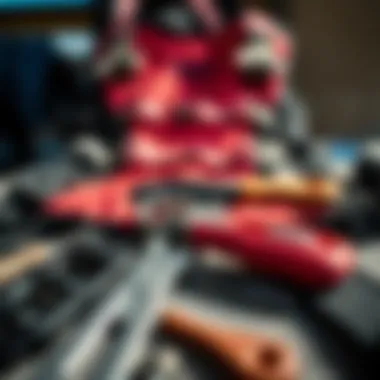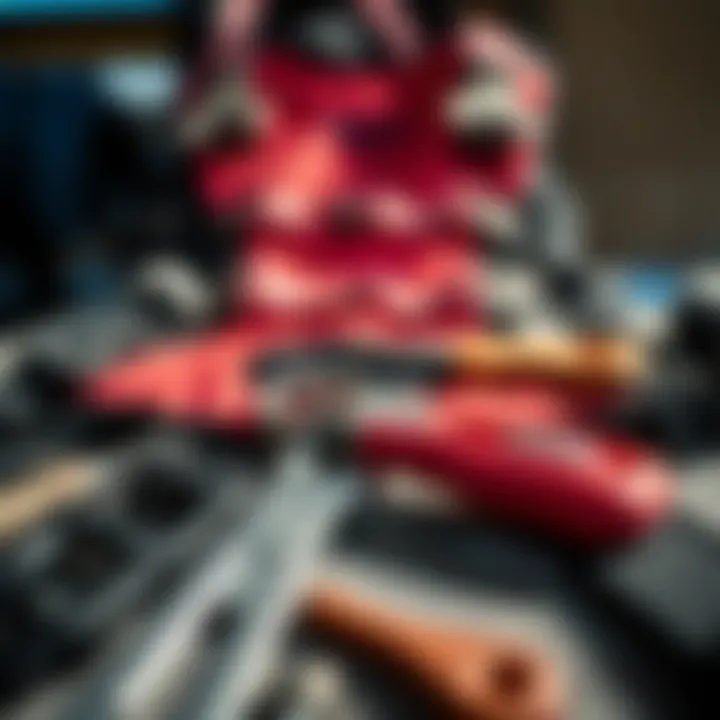The Essential Guide to Kiteboard Harnesses


Intro
Kiteboarding is a thrilling sport that seamlessly combines elements of surfing, windsurfing, and paragliding. As exhilarating as it is, getting started requires more than just enthusiasm; the right gear is crucial. Among this gear, the kiteboard harness stands out as an essential component that directly influences your performance and comfort on the water. This article digs deep into the role of the kiteboard harness, covering everything from its functionalities to the various types available.
A kiteboard harness is not merely a piece of equipment; it forms a vital link between you and the kite. The effectiveness of kite control, stability, and overall riding experience largely hinges on how well you select and utilize this harness. With the right understanding of the features, types, and maintenance of your harness, you can go from struggling in the surf to catching air like a pro.
In the following sections, we will delve into gear and equipment essentials for both beginners and advanced riders, explore basic riding techniques, and provide expert tips to elevate your skills. By the end, you will be equipped with the knowledge necessary to choose the right harness based on your unique needs, enhancing your kiteboarding adventures.
Gear and Equipment
Essential Kiteboarding Gear for Beginners
When starting out in kiteboarding, the right gear makes a world of difference. Alongside having a well-fitted harness, beginners should consider the following items:
- Kite: Selecting a kite that suits your skill level is paramount. Look for a model that offers stability and ease of control.
- Board: A larger board provides better stability, making it more forgiving for newbies.
- Bar and Lines: Your control bar and lines are your lifeline, so ensure they are compatible with your kite.
- Safety Equipment: A helmet and impact vest are advisable, particularly when you are just learning to ride.
The combination of these elements, along with a sturdy harness, can significantly simplify your learning curve, turning frustrations into smooth rides over time.
Advanced Equipment for Experienced Riders
Once a rider has gained confidence and experience, upgrading to advanced gear can elevate performance:
- High-Performance Kites: Experienced practitioners often favor kites that provide enhanced speed and responsiveness.
- Freestyle Boards: Shorter and lighter boards designed for tricks allow for more dynamic movements.
- Boosted Harnesses: Seasoned riders might opt for harnesses with additional features like a spreader bar for optimized load distribution.
Mastering these advanced tools comes with practice and a willingness to experiment. The key to long-term enjoyment in kiteboarding lies in continually refining gear based on your evolving skills and preferences.
Prelude to Kiteboard Harnesses
Kiteboarding is more than just a sport; it’s an exhilarating blend of skill, technique, and the unpredictability of nature. At the core of this excitement lies the kiteboard harness—an often underappreciated piece of gear that plays a pivotal role in the kiteboarding experience. Understanding harnesses is not merely about fashion or preference; it's essential for both safety and performance.
This article dives deep into the significance of kiteboard harnesses, exploring the multitude of styles available and their respective features. Emphasis is placed on the benefits of each type, considerations for personal fit, and ways to ensure that your choice aligns with your riding objectives. Moreover, we'll dissect the sometimes-overlooked aspects of harness maintenance and safety features, making sure you are well-equipped for your adventures on the water.
Let’s begin by taking a closer look at the gear typically involved in the sport and how everything fits together.
Overview of Kiteboarding Gear
Before one even considers a harness, it helps to have a clear picture of the entire kiteboarding setup. At its heart lies a kite, which is paired with lines and a board—these components are critical for maneuverability and speed. There exists a plethora of options when it comes to kites; they vary in size, shape, and intended use, catering to everything from beginners just learning the ropes, to experts tackling challenging conditions.
In addition to the basic components, other vital accessories include:
- Safety Leashes: Essential for quick disconnection during emergencies, these ensure your kite can be easily neutralized.
- Bar and Lines: The control system for the kite, allowing you to steer, trim, and manage power effectively.
- Protective Gear: Things like impact vests or helmets might seem optional, but they serve to safeguard against unexpected falls or hits.
All of these items come together to create a holistic kiteboarding setup. The harness, however, stands out, connecting you directly to the kite, absorbing the force of the pull, and facilitating agile movements on the board. It’s almost like being in a dance—it allows you to move freely while anchoring you in the performance.
The Role of a Harness in Kiteboarding
When you think about it, a harness serves as the bridge between you and your kite—it's what allows you to harness the kite's power without exhausting your arms and back. In essence, it redistributes the load of the harnessed power away from your limbs, letting you focus on the ride itself.
Having the right harness can make a world of difference. A poor fit can lead to fatigue, discomfort, and even injuries. Moreover, it might hamper your ability to control the board effectively or influence your overall enjoyment out on the water.
In summary, the harness plays an essential role in kiteboarding not only through its functional attributes—enabling control and stability—but also by enhancing the overall experience on the water. As you proceed through this article, keep in mind that your harness choice should not be an afterthought. Rather, it deserves as much consideration as your kite or board.
"A well-fitted harness is like a well-tuned instrument; it elevates your performance and ensures a harmonious ride."
Now, let’s unravel the various types of kiteboard harnesses available on the market.
Types of Kiteboard Harnesses
Understanding the different types of kiteboard harnesses is crucial as it influences not just comfort, but also performance on the water. Selecting the appropriate harness can mean the difference between a day of fun sessions or one filled with frustration. Within this realm, kiteboard harnesses can be broadly categorized into three types: waist harnesses, seat harnesses, and hybrid harnesses. Each type comes with its own set of pros and cons, making it essential for riders to consider how they ride, their style, and their personal preferences when making a decision.
Waist Harness
Benefits and Drawbacks
A waist harness is designed to sit snugly around the waist, offering a more mobile feel when kiteboarding. One of the standout features is its ability to allow for greater freedom of movement since it’s positioned higher up on the body. This setup can be particularly beneficial for those looking to perform trickier moves or transitions, as it does not limit leg movement as much as other types might. However, this freedom doesn’t come without potential downsides.


The waist harness can sometimes ride up, leading to discomfort or even chafing during extended sessions. Also, riders with back issues might find the design lacking in support. The balance of benefits and drawbacks makes this style a popular choice among intermediate to advanced riders, where agility and movement are essential to performance.
Recommended Usage
Waist harnesses are often recommended for freestylers and wave riders who enjoy a range of movements and tricks. They’re particularly useful when high jumps and sharp turns are part of the riding style. Still, it's worth noting that for newer riders or those focused on comfort during long sessions, a waist harness may not always be the best option. Adjustability in the straps allows for a custom fit, and selecting the right size is key to ensuring a positive experience on the water.
Seat Harness
Benefits and Drawbacks
In contrast, a seat harness sits lower on the body and wraps around the pelvis, offering more support for the lower back. This design can provide a feeling of security, particularly helpful for beginners or those who may struggle with balance. The key characteristic of a seat harness is its ability to distribute pressure evenly across the body, making it easier to handle the pull from the kite without feeling overwhelmed.
The downside, however, is that the seat harness can restrict movement more than a waist version might, which is not ideal for advanced maneuvers. Riders might also find bending at the hips a bit cumbersome. Many who are just getting their feet wet in kiteboarding find this harness a supportive option, but as they progress, they may seek the freedom offered by a waist style.
Recommended Usage
For those starting out, a seat harness is a great choice. It’s particularly suitable for learners focused on grasping the basics and building confidence on the water. While it's excellent for beginners, improved skills could lead one to transition to a waist harness for enhanced functionality. It can also be a solid choice for those who ride in lower wind conditions where maximum support is necessary rather than high-octane performance.
Hybrid Harness
Benefits and Drawbacks
Hybrid harnesses blend elements from both waist and seat designs, aiming to achieve the best of both worlds. The key characteristic lies in its versatile construction, appealing to those who can't settle on a single style. This makes it a great option for a wide range of activities, including trick riding and casual cruising. It offers the secure feeling of a seat harness while still allowing for enhanced leg movement associated with a waist harness.
Nevertheless, finding the right fit can sometimes be troublesome, as not every hybrid harness will cater to all body types perfectly. Some riders find these harnesses less comfortable than they might hope for and may experience discomfort if the fit isn't just right.
Recommended Usage
Hybrid harnesses shine for those who often switch between different styles of riding, making it a particularly good fit for versatile kiteboarders who may engage in both freestyle tricks and casual cruising. They are also well-suited for intermediate riders who desire a balance of support, comfort, and movement. Ultimately, it’s about figuring out how you ride and aligning your choice with your preferences.
In summary, understanding the types of kiteboard harnesses can significantly impact the kiteboarding experience. Whether it's the mobility of a waist harness, the support of a seat harness, or the versatility of a hybrid, each type has its niche. Thoughtful consideration ensures that riders can enjoy the sport to its fullest potential, keeping both safety and comfort at the forefront of their adventures.
Key Features to Consider
When it comes to choosing a kiteboard harness, understanding the key features is essential for maximizing performance and comfort while riding the waves. Here’s a closer look at what to keep in mind when evaluating harnesses, zeroing in on material and durability, padding and comfort, and adjustability and fit.
Material and Durability
The material of a harness plays a pivotal role in its longevity and overall performance. Most harnesses are made from synthetic materials that withstand wear and tear from salt water, sun exposure, and vigorous movement. High-density polyester is a common choice, known for its resistance to fading and abrasion.
- Nylon Fabric: This is lightweight and flexible, offering ease of movement, but may not be as durable as other options for hardcore riders.
- Neoprene: Often used for padding, neoprene also provides water resistance. It can make the harness more comfortable but can wear out faster if not taken care of properly.
Additionally, check the stitching quality. Double stitching or reinforced seams increases durability. A well-constructed harness can last seasons, saving you money in the long run. Buyers should keep in mind that quality materials may initially cost more but pay off in durability and performance.
Padding and Comfort
Comfort is paramount when you’re out on the water. Padded harnesses usually provide a comfy fit that hugs the body while distributing pressure evenly across the lower back and hips. Insufficient padding can create hotspots that lead to discomfort during a session.
Look for:
- Memory Foam Padding: This type conforms to the body shape and helps alleviate pressure points, making long sessions more enjoyable or at least tolerable.
- Breathable Lining: Helps keep the wearer cool, especially during hot summer days. A sweat-soaked harness is a quick path to discomfort.
- Channel Systems: Some harnesses have channels that allow for better airflow, minimizing the chance of overheating. A good harness won’t feel like a straitjacket; it should move with you throughout your ride.
Adjustability and Fit
Each body is unique, and a good fit can make or break your kiteboarding experience. Harnesses that offer adjustability not only enhance comfort but also ensure that safety features like the safety leash are in the right place. The most common adjustment features include:
- Simplicity of Adjustment: Look for harnesses with user-friendly lever buckles or Velcro straps. If it’s a hassle to adjust, you’re less likely to do it often.
- Cinch Straps: These allow you to tailor the fit more precisely around your waist or hips.
- Size Range: Make sure the size options accommodate different body shapes, so you can find a model that fits snugly yet allows freedom of movement.
"Proper fit not only enhances comfort but can also significantly improve your performance on the water. An ill-fitting harness can lead to a lack of control and discomfort, which no rider wants."
In summary, assessing the material and durability, padding and comfort, along with adjustability and fit, will empower you when selecting the perfect kiteboard harness. A thoughtful approach to these key features can greatly elevate your kiteboarding experience.
How to Choose the Right Harness
Choosing the right kiteboard harness is not just about style or brand; it greatly influences your comfort, control, and overall enjoyment on the water. The relationship between you and your gear is crucial. A well-fitted harness that aligns with your riding style can make the difference between a smooth ride and an exhausting performance session. Moreover, considering various factors, such as your skill level and specific needs, can prevent you from making costly mistakes that could hinder your time on the water.
Assessing Riding Style and Skill Level


Before you even look at harnesses, take a moment to reflect on your riding style. Are you more of a freestyle rider, enjoying jumps and tricks, or do you find joy in cruising with smooth, flowing movements? Each style demands specific characteristics in a harness. For instance, freestyle riders might favor a lighter, more flexible harness, allowing for greater freedom of movement during aerial maneuvers. For those who enjoy surfing, a seat harness could be a better fit, as it offers more support and stability.
Skill level plays a pivotal role too. Beginners should look for harnesses that provide general comfort and hold, while advanced riders may prioritize harnesses that enhance performance and don’t restrict movement. Take time to evaluate how often you kite, the conditions you usually face, and what you’re hoping to achieve in your sessions. Ultimately, understanding your style and skill level will guide you toward the harness that feels just right, like equipping a blade that fits comfortably in the hand for a skilled swordsman.
Trying Before Buying
"Walk a mile in someone’s shoes," they say, and the same goes for harnesses. Before you make a purchase, it’s vital to try on different models. If possible, visit a local shop or a demo day where you can put on several harnesses and see how they feel while you stand, sit, and simulate riding movements. Pay attention to where the harness presses against your body and how it fits both at rest and in motion.
Take note of features like how easily you can adjust the straps. Some harnesses might have complex adjustments that require wrestling with buckles, while others offer a simpler, more user-friendly experience. Also, don’t forget about the overall weight of the harness; you don’t want to lug a heavy piece of gear around when you’re trying to slice through the waves.
If trying on isn't an option, consider looking at customer reviews and forums that provide insights on comfort and fit experiences shared by ordinary riders. Websites like Reddit can be valuable for these discussions, helping you evaluate real-world opinions.
When testing harnesses, keep in mind: comfort, functionality, and indeed personal preference are key. It’s not just about the brand or the latest model; the right harness should feel like a second skin that enables your ability to kite with precision and enjoyment.
Maintenance of Kiteboard Harnesses
In the world of kiteboarding, your harness is your lifeline. It's the connection that keeps you tethered to your kite, allowing you to harness the wind's power while gliding over the water. Yet, many kiteboarders overlook the importance of proper maintenance for these pivotal pieces of equipment. Keeping your harness in top-notch shape not only extends its lifespan but also ensures that you have a safe and enjoyable ride each time you hit the water.
Care Techniques
To maintain your kiteboard harness effectively, you must implement routine care practices. Here are some essential techniques:
- Rinse After Use: Every time you come ashore, especially after a session in salt water, rinse your harness thoroughly with fresh water. Salt can corrode the materials over time, and a simple rinse can make a world of difference.
- Dry Properly: After rinsing, hang your harness in a shaded area to let it dry completely. Avoid direct sunlight as UV rays can weaken the fabric and other components.
- Inspect Regularly: Check for wear and tear regularly. Look for frayed straps, cracks in the spreader bar, or any signs that might indicate that your harness is nearing the end of its lifespan. If you notice anything odd, it might be time to consider replacement.
- Clean Strategically: For deeper cleaning, use mild soap and water. Avoid harsh chemicals that could damage the materials. Gently scrub using a soft brush or cloth, focusing on stubborn areas where dirt may accumulate.
By integrating these care techniques into your routine, you can protect your harness from the elements, resulting in a safer experience on the water.
Storage Solutions
How you store your kiteboard harness is just as important as how you maintain it. Proper storage helps prevent damage and keeps your gear ready for your next adventure. Consider the following storage tips:
- Keep It Dry: Always store your harness in a dry environment to avoid mold growth. A damp environment can create a perfect storm for degradation.
- Use a Gear Bag: Investing in a dedicated gear bag can help shield your harness from accidental damage. When you toss everything into one large bag, it can lead to scratches and wear.
- Avoid Heavy Loads: Don’t place heavy items on top of your harness when storing it. This pressure can distort its shape or even break components over time.
- Organize Accordingly: If you have multiple pieces of gear, keep your harness in an easily accessible location. This practice ensures you can grab it quickly for a spontaneous kiteboarding session.
To get the best out of your kiteboard harness, treating it well is key. Proper maintenance prevents accidents caused by worn out gear and ensures that every ride is as thrilling as it should be.
With a few mindful practices, your kiteboard harness can continue to serve you well, allowing you to focus on the thrill of the ride rather than worrying about your gear.
Safety Features In Harnesses
In the exhilarating world of kiteboarding, where winds whip and waves churn, safety can't be an afterthought. Harnesses are not just a convenience; they are essential for a secure and enjoyable experience on the water. When choosing a harness, understanding the safety features is paramount. These elements are designed to protect you from unforeseen mishaps that can happen while kiteboarding. Let’s break down the crucial safety features that every kiteboarder should consider when selecting a harness.
Release Mechanisms
At the heart of safety in kiteboarding harnesses lies the release mechanism. This gadget is lifesaving in situations where you may need to disengage quickly from the kite. Most modern harnesses incorporate quick-release systems, which allow a rider to detach from the kite in a matter of seconds.
- Importance: If you get pulled under the water or if the kite unexpectedly lurches, being able to release promptly can prevent serious injuries.
- Types of Release Mechanisms:
- Push-Button Release: Simple to use, as it requires just a push to disengage.
- Pull-to-Release: A tug on the handle releases the harness. This type usually comes with a more robust, reliable design that minimizes accidental openings.
Make sure your harness features a mechanism that feels intuitive and easy to operate. It’s wise to practice using it on dry land before hitting the waves.
Safety Leashes
Another vital component of harness safety is the safety leash. This piece acts as a lifeline, reducing the risk of losing control of the kite during a ride.
- Functionality: The safety leash attaches to both the rider and the kite, ensuring that even if you drop the bar, the kite stays connected.
- Types of Safety Leashes:
- Standard Leashes: Basic leashes that increase safety by preventing runaway kites.
- Emergency Leashes: Integrated with a quick-release feature, allowing for rapid disengagement in perilous situations.
It's essential to assess the leash’s durability and length to ensure it suits your riding style. One must test how the leash behaves under tension, as a reliable safety leash ensures peace of mind.
Remember: Regardless of how skilled a kiteboarder you may be, always prioritize safety features in your harness. They can be the difference between a good session and a harrowing experience.
Understanding and ensuring your kiteboard harness is equipped with effective safety mechanisms not only boosts your confidence but also elevates your overall kiteboarding journey. Before heading out, always double-check these features and practice using them to guarantee you're ready to tackle whatever the sea throws at you.
Common Mistakes to Avoid
When it comes to kiteboarding, even the smallest details can make a notable difference. One of the main areas where beginners often trip up involves the harness, a crucial piece of gear that influences comfort and control in the water. Recognizing some common mistakes related to harness usage not only paves the way for improved performance, but it also contributes to a safer, more enjoyable experience. Let's break this down into two significant missteps that kiteboarders should watch out for: neglecting fit and improper maintenance.


Neglecting Fit
One of the most significant blunders kiteboarders can commit is taking the fit of their harness for granted. Sure, it might seem easier to grab whatever size catches your eye or is on sale, but this can lead to disaster down the line. A harness that’s too loose can shift around during rides. This invites discomfort and technical mishaps. Conversely, a harness that’s too tight can constrict movement and even lead to injury during maneuvering.
Finding the right fit can often feel like looking for a needle in a haystack, especially with all the styles and sizes available. To avoid the fit fiasco, consider the following tips:
- Try it On: Always put the harness on before purchasing. Adjust the straps and see how it feels when you’re in a standing position.
- Go for Mobility: Make sure you can move freely. Bend, twist, and even simulate your kiteboarding stance to check if it holds up well.
- Seek Expert Opinion: Don’t hesitate to ask an experienced kiteboarder or shop assistant for advice on sizes and fits. They can often provide insights that make the selection process smoother.
Have a snug fit, but ensure it’s not too restrictive to allow you to focus on conquering the waves rather than fidgeting with an uncomfortable harness.
Improper Maintenance
Let’s face it, proper maintenance is the unsung hero in the world of kiteboarding equipment. Yet, many overlook this aspect, leading to unwelcome surprises during a session. A well-maintained harness not only performs better but also lasts considerably longer, saving you stress and money in the long run.
Here are some straightforward maintenance practices:
- Rinse After Riding: Saltwater and sand are not friends to your harness. After each session, rinse it thoroughly with fresh water to eliminate any residues.
- Inspect Regularly: Look for wear and tear. Check straps, buckles, and any padding to ensure everything is intact. Address any issues immediately to avoid jeopardizing your safety.
- Store Properly: When the season winds down, avoid tossing your harness in the corner. Instead, lay it flat in a cool, dry place to prevent material degradation.
Neglecting proper upkeep can result in a safety hazard when you're out in the water. Establishing a maintenance routine will keep your harness in peak condition and ready for whatever the ocean decides to throw your way.
"Remember, in kiteboarding as in life, it’s the little things that keep the bigger picture afloat."
By steering clear of these common pitfalls—fit and maintenance—kiteboarders pave a smoother path toward mastering the waves. Make it a habit to continually assess your harness fit and care, ensuring both comfort and safety while you ride.
Innovations in Harness Design
Innovations in harness design have sharply influenced the way kiteboarders experience their sport. With the continuous evolution of materials and comfort features, modern harnesses have taken a significant leap from their predecessors. Adapting to the increasing demands of performance and safety, new designs offer better functionality while ensuring that riders focus more on enjoying the ride rather than grappling with equipment issues.
The importance of these innovations cannot be overstated. As kiteboarding becomes more popular, the need for equipment that enhances performance without compromising safety becomes critical. The latest harnesses not only boost efficiency but also enhance the overall riding experience, allowing riders to harness the wind with greater ease and power.
New Materials
The development of new materials has been a game changer in harness design. Traditionally, harnesses were made of heavy fabrics and stiff plastics that, while functional, didn't always provide the flexibility that's important for optimal performance. Nowadays, you’ll see harnesses constructed with lightweight, durable composites like Dyneema and neoprene. These materials are not only lighter but also offer superior resistance to wear and tear.
Take, for example, the use of carbon fiber. Harnesses integrated with this material aren’t just sturdy; they bring a substantial reduction in overall weight. Riders can notice a difference during prolonged sessions on the water, as a lighter harness can significantly reduce fatigue. Additionally, breathable materials allow for better moisture management, keeping riders comfortable even during hot days.
"Lightweight harnesses made from modern materials can make the difference between a tiring session and a thrilling ride."
Enhanced Comfort Features
Comfort is paramount when it comes to harness design. Today’s harnesses feature enhanced comfort elements such as ergonomic shapes, additional padding, and customizable fit. The traditional flat designs are being replaced with contoured forms that match the body's natural curves, thereby distributing pressure more evenly. This results in less strain on specific areas during intense riding sessions.
Moreover, many of the latest harnesses come equipped with adjustable straps and quick-release buckles. These innovations enable kiteboarders to find their perfect fit without hassle. Instead of wrestling with poor adjustments, riders can swiftly modify their harness, ensuring it remains snug and supportive throughout their activities.
Some harnesses now even include built-in lumbar support, which has become increasingly important for those who spend long hours kiteboarding. With better back support, riders can feel more secure and stable as they navigate the waves, which contributes significantly to an improved overall experience.
In summary, as the kiteboarding community strives for excellence, the focus on innovations in harness design reflects a broader commitment to enhancing rider experience. By investing in the latest materials and comfort features, kiteboarders can improve their performance and the joy they derive from their time on the water.
The End
The selection of a kiteboard harness is not just a matter of convenience; it directly impacts a rider's performance and overall enjoyment of the sport. The right harness provides essential support, which translates to more control during rides. When a kiteboarder feels comfortable and secure, they can focus on refining their skills rather than worrying about discomfort or potential injuries.
In this article, we've examined the various components of harness selection, from understanding types – such as waist, seat, and hybrid harnesses – to the importance of fit, comfort, and safety features. Each of these elements contributes significantly to enhancing the kiteboarding experience.
Investing time in selecting the right harness ensures that a rider not only finds their style but also maximizes their safety on the waves. It allows them to push their limits and explore new tricks without the fear of equipment hindering their performance. Whether beginner or advanced, the advice shared in this guide serves all levels of kiteboarders.
As with any outdoor activity, proper maintenance of the harness cannot be overlooked. A well-maintained harness can last for many seasons, making it a worthy investment. The integration of safety features and innovations in harness design also reflect the ongoing evolution within the sport.
Ultimately, understanding one’s own needs and preferences in line with the options available is key to a satisfying kiteboarding journey. With a plethora of designs and functionalities to choose from, good decision-making can lead to numerous memorable sessions on the water.
"Choosing the correct harness is like picking the right shoes for a dance; it influences grace and confidence."
In summary, selecting a harness shouldn't be rushed. Each rider should take the time to experiment, seek advice from fellow kiteboarders, and prioritize what feels right for them. In doing so, they will find a sense of freedom atop the waves, allowing them to enjoy this exhilarating sport to its fullest.
Final Thoughts on Harness Selection
As our kiteboarding adventures unfold, the harness is our silent partner, providing the needed support during high-stakes maneuvers on the water. Rather than viewing it as merely an accessory, consider it an extension of your body that should resonate with your unique riding style.
Reflect upon the various harness types and their specific advantages. For example, waist harnesses offer more mobility, feeling almost like a second skin, while seat harnesses provide extra lower back support which can be a bonus during longer rides. Test out different options in real conditions; how does each harness feel while carving through the waves or soaring under the wind?
When deciding on material preferences, consider durability against water exposure and the effects of salt, as they can be unforgiving on gear. Moreover, keep an eye on the harness’s adjustability; it should allow room for small tweaks that can make a big difference in comfort.
In the end, it may take a few tries to land on the perfect fit. Embrace this process—tracking what works and what doesn't builds experience that will enhance not just your riding, but your appreciation for the intricate dance between kite and board. Happy riding!















